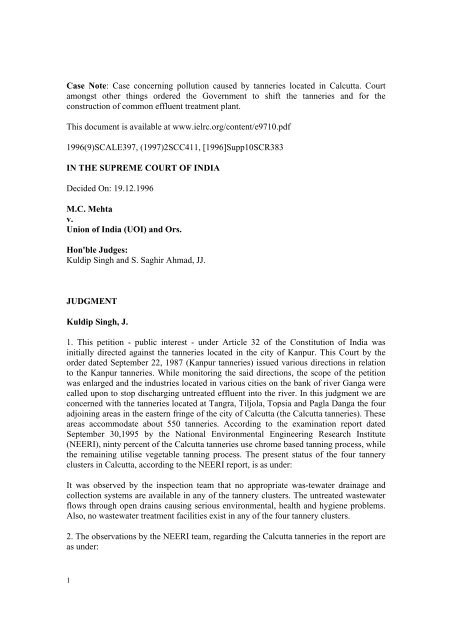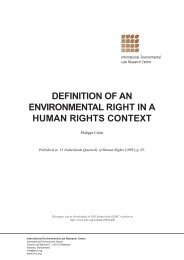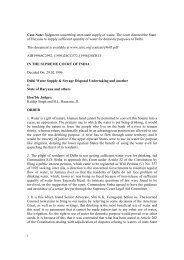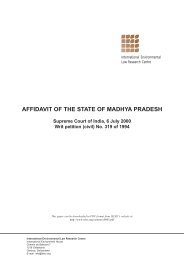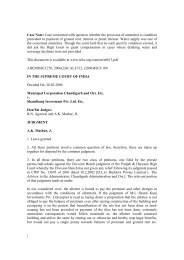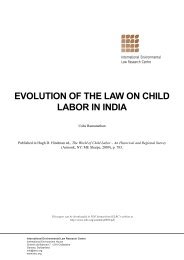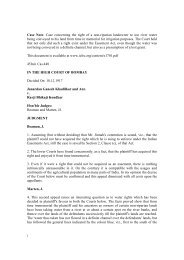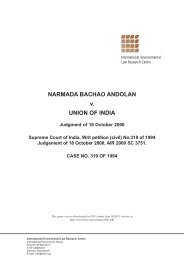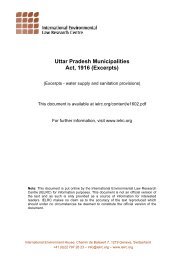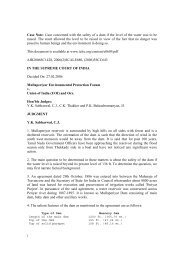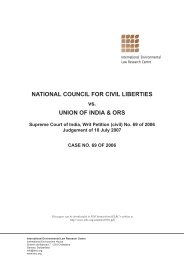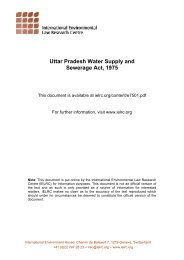M.C. Mehta v. Union of India - International Environmental Law ...
M.C. Mehta v. Union of India - International Environmental Law ...
M.C. Mehta v. Union of India - International Environmental Law ...
- No tags were found...
You also want an ePaper? Increase the reach of your titles
YUMPU automatically turns print PDFs into web optimized ePapers that Google loves.
Case Note: Case concerning pollution caused by tanneries located in Calcutta. Courtamongst other things ordered the Government to shift the tanneries and for theconstruction <strong>of</strong> common effluent treatment plant.This document is available at www.ielrc.org/content/e9710.pdf1996(9)SCALE397, (1997)2SCC411, [1996]Supp10SCR383IN THE SUPREME COURT OF INDIADecided On: 19.12.1996M.C. <strong>Mehta</strong>v.<strong>Union</strong> <strong>of</strong> <strong>India</strong> (UOI) and Ors.Hon'ble Judges:Kuldip Singh and S. Saghir Ahmad, JJ.JUDGMENTKuldip Singh, J.1. This petition - public interest - under Article 32 <strong>of</strong> the Constitution <strong>of</strong> <strong>India</strong> wasinitially directed against the tanneries located in the city <strong>of</strong> Kanpur. This Court by theorder dated September 22, 1987 (Kanpur tanneries) issued various directions in relationto the Kanpur tanneries. While monitoring the said directions, the scope <strong>of</strong> the petitionwas enlarged and the industries located in various cities on the bank <strong>of</strong> river Ganga werecalled upon to stop discharging untreated effluent into the river. In this judgment we areconcerned with the tanneries located at Tangra, Tiljola, Topsia and Pagla Danga the fouradjoining areas in the eastern fringe <strong>of</strong> the city <strong>of</strong> Calcutta (the Calcutta tanneries). Theseareas accommodate about 550 tanneries. According to the examination report datedSeptember 30,1995 by the National <strong>Environmental</strong> Engineering Research Institute(NEERI), ninty percent <strong>of</strong> the Calcutta tanneries use chrome based tanning process, whilethe remaining utilise vegetable tanning process. The present status <strong>of</strong> the four tanneryclusters in Calcutta, according to the NEERI report, is as under:It was observed by the inspection team that no appropriate was-tewater drainage andcollection systems are available in any <strong>of</strong> the tannery clusters. The untreated wastewaterflows through open drains causing serious environmental, health and hygiene problems.Also, no wastewater treatment facilities exist in any <strong>of</strong> the four tannery clusters.2. The observations by the NEERI team, regarding the Calcutta tanneries in the report areas under:1
-Tannery units are located in highly congested habitations, <strong>of</strong>fering little or no scope forfuture expansion, modernization or installation <strong>of</strong> ETP(s)- Tannery units are located in thickly populated residential areas- Surroundings <strong>of</strong> the tanneries are extremely unhygienic due to discharge <strong>of</strong> untreatedeffluents in open drains, stagnation <strong>of</strong> wastewater in low lying areas around the tanneryunits, and accumulation <strong>of</strong> solid waste in tanneries.It is thus obvious that the Calcutta tanneries have all along been operating in extremeunhygienic conditions and are discharging highly toxic effluents all over the areas. ThisCourt on the basis <strong>of</strong> the material on the record in Kanpur-tanneries order observed asunder regarding the noxious nature <strong>of</strong> the tannery-effluent:It should be remembered that the effluent discharge from a tannery is ten times noxiouswhen compared with the domestic sewage water which flows into the river from anyurban area on its banks.Needless to say that the State <strong>of</strong> West Bengal and the West Bengal Pollution ControlBoard (the Board) are wholly re-miss in the performance <strong>of</strong> their statutory obligations tocontrol pollution and stop environmental degradation.3. On February 19, 1993 the State Government informed this Court that the Calcuttatanneries were being shifted from their present location and the new location would befully equipped with pollution control devices. This Court gave three months time to theState Government to take appropriate steps in that direction. The State Government byway <strong>of</strong> an application sought extension <strong>of</strong> time for the shifting <strong>of</strong> the Calcutta tanneries.This Court considered the application on August 13, 1993 and passed the followingorder:The State <strong>of</strong> West Bengal has moved an application for extension <strong>of</strong> time for the shifting<strong>of</strong> over 500 tanneries functioning on the bank <strong>of</strong> the river Ganges. This Court by its orderdated February 19, 1993 gave three months time to the State <strong>of</strong> West Bengal to takeappropriate steps. The relevant part <strong>of</strong> the order is as under:As regards the industries in Group 'D' Part II <strong>of</strong> An-nexure 'A', the State Government issaid to be taking steps for shifting these industries from the place where they arepresently located to another place and to erect a common effluent plant for them in thenew place. In that view <strong>of</strong> the matter, the State <strong>of</strong> West Bengal shall take appropriatesteps within a period <strong>of</strong> three months.We see no ground to grant 3 years time to the State <strong>of</strong> West Bengal. We direct the WestBengal Pollution Control Board to publish a general notice in a Daily paper which ispopular in the said area consecutively for 3 days directing the tanneries to shift their place<strong>of</strong> working within three months from the date <strong>of</strong> publication <strong>of</strong> the notice or in thealternative set up effluent treatment plants to the satisfaction <strong>of</strong> the Board. It shall be2
clearly stated in the notice that in the event <strong>of</strong> failure the functioning <strong>of</strong> the industry atpresent place shall be stopped. The Board shall also issue individual notices to all theindustries within two weeks from the receipt <strong>of</strong> this order.We are prima fade <strong>of</strong> the view that the Government <strong>of</strong> West Bengal cannot back out fromits obligation <strong>of</strong> providing an alternative place <strong>of</strong> working to these tanneries in case theywish to shift their place <strong>of</strong> functioning. We direct the Secretary, Small-Scale Industries,Government <strong>of</strong> West Bengal to be personally present in this Court on 24.9.1993 with aproposal regarding the alternative land or appropriate compensation to be paid to each <strong>of</strong>the industries.This Court on September 24, 1993 directed the Board to examine the possibility <strong>of</strong>setting up <strong>of</strong> common effluent treatment plants for the Calcutta tanneries in the fourareas. The Board was further directed to indicate the cost which was likely to be incurredin the setting up <strong>of</strong> the project. The Calcutta-tanneries were directed to approach NEERIfor the preparation <strong>of</strong> the projects. Pursuant to the directions <strong>of</strong> this Court, the Board filedaffidavit dated October 5, 1993 in this Court. It is stated in the said affidavit that theCalcutta tanneries "are operating for a considerable period <strong>of</strong> time with no regard toenvironmental pollution control virtually shifting <strong>of</strong> the tanneries from the presentlocation to another place and construction <strong>of</strong> common Effluent Treatment Plants, is theonly practicable solution to control the environmental degradation as a whole". Therelevant part <strong>of</strong> the affidavit is as under:3. As per the order <strong>of</strong> the Hon'ble Supreme court dated 24th September, 1993, TechnicalOfficers <strong>of</strong> the Board have examined the possibility <strong>of</strong> setting up a common EffluentTreatment Plant for the tanneries situated in Tiljala, Topsia and Tangra area which arelocated in the eastern fringe <strong>of</strong> Calcutta.A layout map indicating the location <strong>of</strong> the tanneries in Tiljala, Tangra and Topsia areaalongwith a diagram mentioning the number <strong>of</strong> tanneries in such areas are also enclosedherewith collectively and marked as Annexure - 'A'.I It reveals from the inspection that adequate space is not available in Tiljala, Tangra andTopsia area for construction <strong>of</strong> Common Effluent Treatment Plant.In this connection it can be mentioned that Tanneries situated at Tiljala, Tangra andTopsia area are operating for a considerable period <strong>of</strong> time with no regard to environmentpollution control.After the enactment <strong>of</strong> the Water (Prevention & Control <strong>of</strong> Pollution) Act, 1974 in theState <strong>of</strong> West Bengal, tanneries <strong>of</strong> the said locality never applied for consent to the StatePollution Control Board. Only in the year 1989, more than one hundred tanneries appliedfor consent to the State Board after long persuasion.Considering their practical problem, State Board issued consent under the Water(Prevention and Control <strong>of</strong> Pollution) Act, 1974, to tanneries for six months only in the3
year 1989 with a condition that within the validity period <strong>of</strong> consent i.e. within 6 (six)months, the said tanneries will construct primary effluent treatment plant and submit ascheme <strong>of</strong> secondary effluent treatment plant. But unfortunately none <strong>of</strong> the tanneriessituated in the said area constructed or have taken any steps for construction <strong>of</strong> effluenttreatment plant.Therefore, State Board issued legal notice to the tanneries in the year 1992. Show causenotices were also issued by the State Board asking why their factory may not be directedto be closed for not putting up right type <strong>of</strong> effluent treatment plant as per the order <strong>of</strong>Hon'ble Supreme Court dated 1st December, 1992.Subsequently more than 275 nos. <strong>of</strong> tanneries applied for consent to the State Board butin view <strong>of</strong> the Hon'ble Supreme Court's order dated 19th February, 1993, "Consent" wasnot granted to any <strong>of</strong> the tanneries. Moreover tanneries <strong>of</strong> the said area were directed tosubmit an undertaking in the court stamp paper that they are willing to move to any placeas fixed up by the Government <strong>of</strong> West Bengal.Accordingly, more than 280 tanneries submitted their undertaking in 'Court Stamp Paper'that they are willing to move to any place as fixed up by the Government <strong>of</strong> West Bengalfrom their present location.5. That, due to the existence <strong>of</strong> the tanneries without having any treatment facilities inTangra, Tiljala and Topsia area, environmental degradation in such areas and theirsurroundings are extremely alarming. Virtually shifting <strong>of</strong> the tanneries from the presentlocation to another place and construction <strong>of</strong> common Effluent Treatment Plant, is theonly practicable solution to control the environmental degradation as a whole.4. The matter came up for further consideration on October 15, 1993. This Court agreedwith the above quoted opinion <strong>of</strong> the Board and came to the conclusion that the onlyviable solution was to relocate the Calcutta Tanneries. This Court further passed thefollowing order:Mr. Satendra Nath Ghosh; Secretary, Department <strong>of</strong> Cottage and Small Scale Industries,Government <strong>of</strong> West Bengal has stated in his affidavit dated September, 1993 that theGovernment <strong>of</strong> West Bengal has already identified 507.27 acres <strong>of</strong> land to be acquired orsetting up the tanneries complex. He has further stated that on technical advice, theGovernment is thinking <strong>of</strong> having a bigger project and as such the acquisitionproceedings in respect <strong>of</strong> the above said land have not been initiated.Along with the affidavit a Notification dated July 28, 1992 has been annexed. By the saidNotification a Monitoring Committee for the integrated leather complex to be set up inthe District <strong>of</strong> South 24 Parganas has been constituted. The Committee consists <strong>of</strong> 19members including the Minister Incharge, Cottage and Small Scale Industries, MinisterIncharge, Sunderbad Development Board, Secretary, Cottage and Small Scale Industries,Secretary, Commerce and Industries Department, Secretary to the Chief Minister <strong>of</strong> WestBengal, the Secretary, Irrigation and Waterways Department, Secretary, Environment4
Department, Secretary, Public Health Engineering and various other highly placed<strong>of</strong>ficers connected with the project. Thereafter the Deputy Secretary to the Government<strong>of</strong> West Bengal in the Department <strong>of</strong> Land and Land Revenue addressed a letter datedJuly 13, 1993 to the Collector <strong>of</strong> South 24 Parganas informing him that a decision hasbeen taken on the government level to acquire the land measuring 507.27 acres in mouzasKaraldanga and others, P.S. Bhangor in the District <strong>of</strong> South 24 Parganas for theintegrated leather complex under the provisions <strong>of</strong> the West Bengal Land Requisition andAcquisition Act 1948 (the Act) as a special case. By another letter dated August 23, 1993,the Governor <strong>of</strong> West Bengal has accorded sanction <strong>of</strong> Rs. 60 lacs for meeting theacquisition expenses towards acquisition <strong>of</strong> land measuring 507.27 acres, under the abovementioned Act.It is, thus obvious that the West Bengal Government have already taken steps to acquire507.27 acres <strong>of</strong> land for the tanneries complex. There is no reason why the plan shouldnot go ahead and be completed within a reasonable time. We direct the Minister, InchargeCottage and Small Scale Industries Department, who is the Chairman <strong>of</strong> the Committee,to proceed with the Project in accordance with the following time schedule.1. The Committee shall entrust the project to a technical authority like the National<strong>Environmental</strong> and Engineering Research Institute or any other equally competentauthority for preparing a project in this respect. The expenditure for getting the projectprepared shall be met by the West Bengal Government. The project should be gotprepared on war-footing and be prepared within a period <strong>of</strong> two months <strong>of</strong> the receipt <strong>of</strong>this order.2. The procedure for acquiring the land measuring 507.27 acres under the Act shall becommenced within one month from the receipt <strong>of</strong> this order and shall be completedexpeditiously.3. After the acquisition proceedings are completed and land is taken in possession <strong>of</strong> theState Government shall get the land developed through the authorities under the control<strong>of</strong> the State Government. This shall be done within three months thereafter.As at present we give the above directions to the Monitoring Committee. The Secretary,Department <strong>of</strong> Cottage and Small Scale Industries shall keep on sending the progressreport to this Court after every four weeks. After the above quoted steps are completed inaccordance with the schedule given by us, further directions hi this respect shall be given.We make it clear that any violation <strong>of</strong> this order shall attract the provisions <strong>of</strong> theContempt <strong>of</strong> Court Act.5. While examining the progress made in the execution <strong>of</strong> the project in terms <strong>of</strong> theabove quoted directions this Court on February 25, 1994 passed the following order:We directed the Minister Incharge, Cottage and Small Industries Department, Chairman<strong>of</strong> the Committee to proceed with the projects on war-footing and have the project reportprepared within the period <strong>of</strong> two months from October 14, 1993. We have been5
informed by the learned Counsel appearing for the State <strong>of</strong> West Bengal that apreliminary report has been received from the Central Leather Research Institute,Madras, but the design and estimate are yet to be received. We are <strong>of</strong> the view that theproject is not being executed in accordance with the time schedule directed by this Court.We request and direct Mr. Probir Sengupta, Minister Incharge, Cottage and SmallIndustries to file an affidavit in this regard within two weeks explaining the progress inthe project and also the reasons, if any, why the time schedule fixed by this Court is notbeing followed. We make it clear that the affidavit should be filed in this Court on orbefore 15.3.1994. We further direct the Minister Incharge to depute a responsible <strong>of</strong>ficerto be present in this Court on the date when we take up the affidavit for consideration.6. Pursuant to the above quoted order <strong>of</strong> this Court, Probir Sen Gupta, Minister Incharge,Department <strong>of</strong> Cottage and Small Scale Industries, Government <strong>of</strong> West Bengal filedaffidavit in his capacity as the Chairman <strong>of</strong> Monitoring Committee set up by StateGovernment by the notification dated July 28, 1992 to monitor the new integrated leathercomplex. The affidavit stated as under:....About 1,000 acres <strong>of</strong> land has already been acquired and possession taken for settingup the Calcutta Leather Complex. It is stated by the learned Counsel appearing for theMinister that the Calcutta Leather Complex includes the tanneries and all other alliedleather industries. It is stated that the Project Report in respect <strong>of</strong> the complex has beenreceived from the Central Leather Research Institute, Madras. We are <strong>of</strong> the view that thedevelopment <strong>of</strong> the Complex should be done in a phased manner. Top priority has to begiven to the tanneries which are to be shifted from Calcutta to the new Complex. TheProject which has been prepared by the Calcutta Leather Research (in short - CLRI)relates to the tanneries as well as other allied industries to be set up at the new complex.We direct the State <strong>of</strong> West Bengal to take up that part <strong>of</strong> the Project for implementationin the first instance which relates to the tanneries. While doing so, if any technicaldifficulty arises, the State <strong>of</strong> West Bengal may immediately approach the CLRI throughits Deputy Director, Dr. Mariappan, to render the advice asked for within two weeks <strong>of</strong>the receipt <strong>of</strong> the requisition. Of course, the Institute shall be entitled to its normal feesfor rendering the advice.Meanwhile, we direct the State <strong>of</strong> West Bengal to assess the need <strong>of</strong> each <strong>of</strong> the tannerieseither directly or through the Association (the learned Counsel has informed us that anAssociation is in the process <strong>of</strong> being formed) regarding the extent <strong>of</strong> land and otherfacilities required by them. This is to be done within four weeks from today and a reportbe filed in this Court. We further direct the State <strong>of</strong> West Bengal to take into hand thedevelopment <strong>of</strong> the acquired area either directly or through the Association. Copy <strong>of</strong> theorder be sent to the West Bengal Government and to the Minister personally.7. This Court took up the matter for further monitoring on July 29, 1994. JyotirmoyGhosh, Joint Secretary, Department <strong>of</strong> Cottage and Small Scale Industries Government <strong>of</strong>West Bengal, had filed an affidavit indicating the progress made in the relocation <strong>of</strong>Calcutta tanneries. After examining the contents <strong>of</strong> the affidavit this Court passed thefollowing order:6
We are prima facie satisfied that no steps at all have been taken by the Government <strong>of</strong>West Bengal to comply with our orders reproduced above. We issue notice returnable on19.8.1994 to (through speed post/fax) Mr. Prabir Sengupta, Minister Incharge,Department <strong>of</strong> Cottage and Small Scale Industries, Government <strong>of</strong> West Bengal, and Mr.Jyotirmoy Ghosh, Joint Secretary, Department <strong>of</strong> Cottage and Small Scale Industries,Government <strong>of</strong> West Bengal to show cause why contempt proceedings be not institutedagainst them. Meanwhile, we give them opportunity to file further affidavit showingcompliance, if any, <strong>of</strong> this Court's orders made by the State <strong>of</strong> West Bengal.8. This Court on September 9, 1994 considered the affidavits filed by Probir Sen Gupta,Minister Incharge and by Jyotirmoy Ghosh, Joint Secretary respectively <strong>of</strong> the State <strong>of</strong>West Bengal. After hearing Mr. N.N. Gooptu, learned Advocate General, State <strong>of</strong> WestBengal, this Court passed the following order:We are prima facie satisfied that there has been no effort on the part <strong>of</strong> the West BengalGovt. to comply with the directions given by this Court. Despite our finding, we restrainourselves and refrain from issuing contempt notice to the Minister and the Joint Secretaryat this stage.We reiterate our earlier direction given on April 15, 1994 and expect the State Govt. tocomply with the same fully within a period <strong>of</strong> 8 weeks from today. During the course <strong>of</strong>arguments, we have given sufficient indication to the learned Advocate General as to howthe State <strong>of</strong> West Bengal is to proceed in this matter. We indicate that the State Govt.shall issue individual notices to each <strong>of</strong> the tanneries indicating that as per this Court'sorder, all the tanneries have to be shifted from their existing place <strong>of</strong> work to the placewhich has already been acquired by the State Govt. They shall be asked to give theirrequirements regarding land, financial assistance and any other assistance which theyneed within the specified period. The State Govt. shall also indicate thereafter by a publicnotice the mode <strong>of</strong> transferring the land and the mode <strong>of</strong> payment <strong>of</strong> the price by thetanneries. Meanwhile, the State Govt. shall take immediate steps to develop the land inthe sense that it shall start working on the sewage system, water works, electricity andother amenities and construction work which is to be done. We make it clear that we haveonly indicated some <strong>of</strong> the steps which are necessary in the process <strong>of</strong> shifting thetanneries from their present place <strong>of</strong> work. It is for the State Govt. to have a detailedscheme prepared and have the project completed within a phased manner.Mr. Harish N. Salve, learned senior counsel appearing for the Tanneries Association hasvery fairly stated that they have no objection in shifting to the new place provided all thefacilities are given to them by the State Govt. He further states that the main difficulty intheir way is the setting up <strong>of</strong> an Effluent Treatment Plant. The State Govt. shall have anestimate prepared immediately regarding the expenditure and the time it is going to takein setting up the E.T.P. We shall thereafter apply our mind to find out the way to poolfinancial sources from the State Govt., Central Government and the Tanneriesthemselves.7
9. On February 20, 1995 this Court was informed that the estimated cost <strong>of</strong> the land in thenew complex would be Rupees 860.00 per square meter. Learned Counsel appearing forthe Calcutta tanneries, however, contended that the price suggested was on the higherside. Various suggestions for reducing the cost <strong>of</strong> land were considered and finally theCourt passed the following order:Mr. Ajoy Sinha, Principal Secretary to the Government <strong>of</strong> West .Bengal and Secretary Department <strong>of</strong> Cottage and Small Scale Industries has filed twoaffidavits dated February 7, 1995 and February 16, 1995 on behalf <strong>of</strong> the State <strong>of</strong> WestBengal in Tanneries Matter. The affidavits be taken on record.We have heard Mr. M.C. <strong>Mehta</strong>, Mr. Dalip Sinha and Mr. G. Ramaswamy. Mr. AjoySinha has annexed copy <strong>of</strong> the Notice dated January 10, 1995 served on all the tanneriesalong with the affidavit dated February 7, 1995. It has been mentioned in para VI <strong>of</strong> thenotice that the estimated cost <strong>of</strong> the land in the new complex would be Rs. 860.00 per sq.metre. It is further stated that this has been worked out on the basis <strong>of</strong> the total estimate<strong>of</strong> the cost, which according to the State Government, comes to about Rs. 130 crores. Mr.G. Ramaswamy, learned senior counsel appearing for the tanneries has informed us thatduring the course <strong>of</strong> discussion between the representatives <strong>of</strong> the tanneries and theGovernment <strong>of</strong>ficials, it was disclosed that cost <strong>of</strong> the common effluent treatment plant tobe set up at the new complex would come to about Rs. 65 crores. The Co-ordinatingCommittee <strong>of</strong> the Calcutta Tanneries has, in its letter dated February 15, 1995, informedthe Government that they are willing to shift to the new complex. The main objectionraised by the tanneries is that the price as Rs, 860.00 per sq. metre is excessive and verymuch on the higher side. We have no doubt that the Government must have fixed theprice per square metre on "no pr<strong>of</strong>it no loss" basis.We are <strong>of</strong> the view, that the amount <strong>of</strong> Rs. 65 crores, to be spent on the construction <strong>of</strong>the common effluent treatment plant, should initially be founded by the Government orfrom some other source provided by the Government. After the treatment plant isconstructed and the tanneries are shifted to the new complex an "effluent charge" can belevied on the tanneries for reimbursing the amount spent on the common effluenttreatment plant in a phased manner. This arrangement can bring down the initial cost tobe incurred by the tanneries.We issue notice to the Government <strong>of</strong> West Bengal through Deptt. <strong>of</strong> Industries, Ministry<strong>of</strong> Environment and Forests - <strong>Union</strong> Government, the Ganga Project Directorate and theState Pollution Control Board. These authorities shall give their reaction to oursuggestion within a period <strong>of</strong> two weeks from today. Affidavits shall be filed by all theseauthorities within ten days from today. Registry to send copies <strong>of</strong> this order to all theabove-mentioned authorities within two days by speed post.10. Pursuant to the order dated February 29, 1995, Ganga Project, Directorate andMinistry <strong>of</strong> Environment and Forests filed affidavit wherein it was stated that "theamounts provided under the plan are for specific items <strong>of</strong> works approved by the Central8
Ganga Authority. Under the circumstances, It may not be feasible to divert earmarkedfunds for other purposes". On February 24, 1995 this Court passed the following order:We are <strong>of</strong> the view that the Ministry <strong>of</strong> Environment and Forest be requested toreconsider the matter and also the allocations it has made for various projects under theGanga Action Plan and include if possible the Tanneries Project in West Bengal in thePlan to be executed in the near future. The Ministry must find out a way to found theTanneries Project as suggested by this Court in the order dated Feb., 20,1995. We adjournthe matter for three weeks to enable the Ministry and the Ganga Project Directorate toreconsider the whole matter and file a fresh affidavit in this Court within the aboveperiod. Copy <strong>of</strong> this order may be sent to the Ministry <strong>of</strong> Environment and Forest and tothe Ganga Project Directorate.11. Pursuant to the above quoted order <strong>of</strong> this Court Bhag Singh, Deputy Secretary,Ganga Project Directorate filed affidavit dated April 6, 1995. Para 6 <strong>of</strong> the affidavit statedas under:It is now submitted that in view <strong>of</strong> the above observations <strong>of</strong> the Supreme Court, theGanga Project Directorate in the Ministry <strong>of</strong> Environment & Forests will prepare ascheme <strong>of</strong> Common Effluent Treatment Plant hi West Bengal and move for its inclusionin Phase II <strong>of</strong> Ganga Action Plan. It is further submitted that this scheme like otherschemes under Ganga Action Plan Phase II will have to be funded by the Centre and theState Government on 50:50 basis. The proposal for the. scheme will be called from theState Government <strong>of</strong> West Bengal and after due examination will be submitted for theapproval <strong>of</strong> Expenditure Finance Committee, the Planning Commission and the CabinetCommittee on Economic Affairs.12. Agreeing with the Ganga Project Directorate that project would be included in theGanga Action Plan Phase II, this Court on April 7, 1995 passed the following order:We agree with the Ministry <strong>of</strong> Environment & Forests that the project <strong>of</strong> setting up <strong>of</strong>Common Effluent Treatment Plant for about 540 tanneries, to be re-located, be includedunder Ganga Action Plan Phase II. Mr, Gooptu, learned Advocate General, appearing forthe State <strong>of</strong> West Bengal, very fairly states that it would be possible for the State <strong>of</strong> WestBengal to meet 50% <strong>of</strong> the cost <strong>of</strong> the Project. He further states that the State will arrangethe funds either from its own sources or from financial institutions or other sources.Therefore, it is agreed by all that the Project <strong>of</strong> setting up <strong>of</strong> Common Effluent TreatmentPlant shall be undertaken under the Ganga Action Plan Phase II and its total cost <strong>of</strong> Rs.65 crores shall be met 50% by the Ganga Project Directorate and the remaining 50% bythe State Government in the manner indicated by the learned Advocate General. Wereiterate that after the treatment plant is constructed and the tanneries are shifted to thenew complex, "Effluent Charge" shall be levied on the tanneries for reimbursing theamount spent on the common Effluent Treatment Plants in a phased manner. Needless tosay that the money collected in that manner shall be divided half and half by the State <strong>of</strong>West Bengal and the Ministry <strong>of</strong> Environment and Forests. We direct the State <strong>of</strong> WestBengal through the Department <strong>of</strong> Cottage and Small Scale Industries to prepare and9
send the Project for setting up <strong>of</strong> Common Effluent Treatment Plant for the tanneries tothe Ganga Project Directorate within one month from the receipt <strong>of</strong> this order. The GangaProject Directorate shall thereafter examine the project within two weeks and send thesame for approval <strong>of</strong> expenditure to the Finance Committee <strong>of</strong> the Planning Commissionand the Cabinet Committee on Economic Affairs. We request the Finance Committee,Planning Commission and the Cabinet Committee on Economic Affairs to expedite thesanctioning <strong>of</strong> the project as and when it is received by these authorities.Mr. Gooptu, leaned Advocate General states that the total cost <strong>of</strong> the project has beenestimated at Rs, 158 crores. He further states that the price <strong>of</strong> the land as Rs. 860 per sq.metre was determined on the basis <strong>of</strong> the estimated cost <strong>of</strong> the leather Complex. SinceRs. 65 crores are now being spent by the Ganga Project Directorate, and the State <strong>of</strong> WestBengal, the total price for the purposes <strong>of</strong> market value has to be reduced. After doingthis exercise, all present agree that the price comes to Rs. 600 per sq. metre.We direct the State <strong>of</strong> West Bengal to go ahead with the relocation <strong>of</strong> tanneries from thepresent sites to the new complex by <strong>of</strong>fering the plots to the individual tanneries at Rs.600 per sq. metre. The State <strong>of</strong> West Bengal shall keep in mind the requirements <strong>of</strong> each<strong>of</strong> tanneries so far as the area is concerned, but in no case the area lesser than the areaalready occupied by the tanneries shall be <strong>of</strong>fered to them.The State <strong>of</strong> West Bengal shall issue public notices <strong>of</strong>fering land in the new complex tothe tanneries at Rs. 600 per sq. metre. We direct the West Bengal Pollution Control Boardto issue individual notices to all the tanneries informing them that the land is being<strong>of</strong>fered by the State <strong>of</strong> West Bengal in the new complex. The Board shall further informthe tanneries that all necessary amenities and facilities necessary for setting up <strong>of</strong>tanneries in the new complex, shall be provided. The Board shall indicate in the noticesthat the <strong>of</strong>fer <strong>of</strong> the State Government for purchase <strong>of</strong> plots in the new complex shall beaccepted within two weeks <strong>of</strong> the receipt <strong>of</strong> the notices. We make it clear that thetanneries who fail to avail the opportunity <strong>of</strong>fered by the State <strong>of</strong> West Bengal to shift tothe new complex shall be liable to be closed without any further notice. Mr. Gooptu,learned Advocate General states that the plots shall be <strong>of</strong>fered to those tanneries who willdeposit 25% <strong>of</strong> the total purchase price at the rate <strong>of</strong> Rs. 600 per sq. metre.State <strong>of</strong> West Bengal to file an affidavit by 21st April, 1995 giving the progress madepursuant to this order.A copy <strong>of</strong> this order be sent to all the concerned authorities. We make it clear right at thisstage that the area vacated by the tanneries shall be maintained as a green area in anyform at the discretion <strong>of</strong> the State Government.13. Pursuant to the above quoted order, the Board issued notices to all the Calcuttatanneries. The Board also issued public notices in four newspapers namely. TheStatesman (English), The Telegraph (English), Aajkal (Benali) and Ganashakti (Bengali).The notices served on the tanneries and published in the newspapers stated that all theCalcutta tanneries should approach the State Government for allotment <strong>of</strong> plots in the10
Bengal Government may also be consulted by the NEERI & Kr<strong>of</strong>ta. The NEERI mayinform the time and date <strong>of</strong> its visit to the following advocates: 1.Mr. Ashok Sen, St. Adv. 19Teen Murti Lane,New Delhi. Tele.3793259Fax. 3792237, 30169362. Mr. Shanti Bhushan, Sr. Adv.Res. B-16, Sector 14 NOIDA.Tel. 8527412, 8520348Off, C-67, Sector 14, NOIDATel. 8522668, Fax. 8525729Ch. 412, <strong>Law</strong>yers Chambers,Delhi High Court,New Delhi. 33852663. Mr. G. Ramaswamy, Sr. Adv.Res. A-7, Sector 14, NOIDATel. 8524357, 8526101Off. E-210, Greater Kailash,New Delhi. Tel. 6425796, 6428943,6476878 (F)4. Mr. N.N. Guptoo,Advocate General,State <strong>of</strong> West Bengal.5. Mr. Mahesh Chander <strong>Mehta</strong>,Res. 3, Ring Road(next to Vikram Hotel),Lajpat Nagar IV, New DelhiTel. 6436512Off. 5, Anand Lok, New DelhiTel. 6445214, 6446145Since we are already in the process <strong>of</strong> hearing final arguments and there is an urgency inthe matter we request Mr. P. Khanna to have the matter examined and file a report withinthree weeks from the receipt <strong>of</strong> this order. Mr. Imtiaz Ahmad, learned Counsel will filethree copies <strong>of</strong> the project report along with one copy <strong>of</strong> the brochure pertaining toKROFTA. The Registry shall send by speed post/fax one copy <strong>of</strong> the same to NEERIalong with this order13
The expenses <strong>of</strong> the NEERI shall be borne by Mr. Shanti Bhushan's clients.We make it clear that other tanneries which are located in Tiljala, Topsia and Pagla Dargamay, if they have joint project like that <strong>of</strong> Tangra, the same be placed before the visitingteam <strong>of</strong> NEERI for their inspection and' report.This Court has been monitoring this petition for a along time primarily with a view tocontrol pollution and save the environment. In the process the Calcutta tanneries havebeen extended all possible help to re-locate themselves to the new complex. Despiterepeated reports by the Board that the Calcutta tanneries were/are discharging highlynoxious effluent and are polluting the land and the river, this Court did not order theclosure <strong>of</strong> the tanneries because they agreed before this Court and had given clearundertaking that they would relocate to the new complex. Inspite <strong>of</strong> all the efforts madeby this Court to provide every possible facility to the Calcutta tanneries to shift to thenew complex they remained wholly non-cooperative. With a view to control the pollutiongenerated by the Calcutta tanneries this Court in the order quoted above agreed toexamine the proposal regarding setting up <strong>of</strong> common effluent treatment plants at theexisting areas where the tanneries are operating. This Court directed NEERI to examinethe feasibility <strong>of</strong> the projects. NEERI submitted its report dated September 30, 1995. Thereport indicates that a four member team in-spected the existing sites <strong>of</strong> tanneries clustersand examined the issues relating to the proposed common effluent treatment plants andtheir locations at Tangra, Tiljola, Topsia and Pagla Danga in Calcutta. The conclusionsreached by the NEERI are as under:5.0 ConclusionsOn review <strong>of</strong> the proposed CETP schemes for tannery was-tewater management atTangra, Tiljola, and Topsia by M/s. Kr<strong>of</strong>ta Engineering Ltd., Chandigarh and M/s. BOC,Calcutta at Pagla Danga; and after detailed discussions with the consultants, theinspection team notes that- The proposed schemes are neither scientifically sound, nor can be constructed on theexisting locations without interfering with the normal life <strong>of</strong> the residents in abovementioned areas- The proposed CETP schemes are not capable <strong>of</strong> treating the wastewater laden with hightotal dissolved solids, chromium, and nitrogeneous constituents. Thus the proposed CETPdesigns cannot control pollution and odour in totality at the tannery clusters at Tangra,Tiljola, Topsia, and Pagla Danga- The proposed designs have little scientific basis, and do not consider the industry -specific requirements <strong>of</strong> effective wastewater treatment in tannery clusters at TangraTiljola, Topsia and Pagla Danga.In view <strong>of</strong> categoric findings <strong>of</strong> the NEERI and also several reports by the Board there isno possibility <strong>of</strong> setting up <strong>of</strong> common effluent treatment plants at the existing locations14
<strong>of</strong> the Calcutta tanneries. In the facts and circumstances, discussed in this judgment, wehave no hesitation in holding that the Calcutta tanneries shall have to be relocated fromtheir present locations.15. We may at this stage deal with the contention raised by learned Counsel for theCalcutta tanneries that the she where the new leather complex is being set up is a part <strong>of</strong>the wet land. Pursuant to this Court's order dated July 14, 1995 Ajoy Sinha, PrincipalSecretary and Secretary, Department <strong>of</strong> Cottage and Small Scale Industries, Government<strong>of</strong> West Bengal filed affidavit dated July 29, 1995. Para 7(d) <strong>of</strong> the affidavit is as under:It is further submitted that the said area is clearly outside the boundaries <strong>of</strong> the wetlandarea as claimed by the writ petitioners in O.K. No. 2851 <strong>of</strong> 1992 in the court <strong>of</strong> Mr.Justice Umesh Chandra Banerjee in the Calcutta High Court, This will appear from themap and report submitted by the Collector, South 24 Parganas which are annexed heretoand marked Letter 'C' and Cl' respectively.Along with the affidavit the Principal Secretary has annexed letter dated July 12, 1995from District Magistrate, South 24 Pgs. addressed to the Principal Secretary. Theoperative part <strong>of</strong> the letter is as under:Kindly recall your verbal instruction in the matter indicated above. A sketch map hasbeen prepared on the Thana map showing the location <strong>of</strong> "Wetland" as shown inAnnexure - 'C' <strong>of</strong> the case referred above as also the location <strong>of</strong> the proposed CalcuttaLeather Complex. It is evident from the sketch plan enclosed herewith that easternboundary <strong>of</strong> the "Wetland" falls to the West and is beyond the boundary <strong>of</strong> the proposedCalcutta Leather Complex site. The technical report prepared by the surveyor is alsoenclosed herewith.Incidentally, it may be mentioned that the bherries mentioned in the Writ Petn. aresituated within the boundary <strong>of</strong> Annexure -'C' <strong>of</strong> the Writ Petn. <strong>of</strong> the case mentionedabove.It, therefore, shows that the area <strong>of</strong> the proposed Calcutta Leather Complex does not fallwithin the area <strong>of</strong> the Wetland.The Technical Report by the surveyor indicating that the new leather complex does notfall within the area <strong>of</strong> the wetland has also been attached along with the affidavit <strong>of</strong> thePrincipal Secretary. The site plan enclosed with the affidavit clearly shows that theleather complex is outside the boundary <strong>of</strong> the wet land. No material to the contrary hasbeen placed on record by the Calcutta tanneries. We, therefore, reject the contention <strong>of</strong>the learned Counsel that the new leather complex is a part <strong>of</strong> the wet land.16. As a result <strong>of</strong> the monitoring done by this Court towards re-location <strong>of</strong> the Calcuttatanneries the following steps to facilitate the re-location have been undertaken:15
1. The State Government has acquired and taken possession <strong>of</strong> the land for setting up <strong>of</strong>the new tanneries complex.2. The State Government has repeatedly <strong>of</strong>fered plots to the Calcutta tanneries in the newcomplex but they have not as yet accepted the <strong>of</strong>fers.3. 25% <strong>of</strong> the land-price in the new complex was to be deposited by May 15, 1995 butdespite extension asked by the Calcutta tanneries and granted by this Court the moneyhas not been deposited.4. The price <strong>of</strong> land in the new complex was fixed at Rs. 860 per sq. meter. At ,the asking<strong>of</strong> the tanneries the price has been reduced to Rs. 600 per sq. meter by High Court.5. The State Government is ready and willing to extend all the concessions and benefitnecessary in the process <strong>of</strong> relocation.6. A very large number <strong>of</strong> Calcutta tanneries are operating without setting up <strong>of</strong> thepollution control devices. Highly noxious and poisonous effluents are being dischargedon the surrounding areas and in the river.7. The NEERI and the Board have authoritatively opined that common effluent treatmentplants cannot be constructed at the sites where the Calcutta tanneries are at presentoperating.17. The Calcutta tanneries are even otherwise operating in violation <strong>of</strong> the provisions <strong>of</strong>the Water (Prevention and Control <strong>of</strong> Pollution) Act, 1974 (the Water Act). Sections2(dd), (e), (J), (k) 24(l)(a), 25(1), (2) and 26 <strong>of</strong> the water Act are as under:2(dd) "outlet" includes any conduit pipe or channel, open or closed, carrying sewage ortrade effluent or any other holding arrangement which causes or is likely to cause,pollution.(e) "pollution" means such contamination <strong>of</strong> water or such alteration <strong>of</strong> the physical,chemical or biological properties <strong>of</strong> water or such discharge <strong>of</strong> any sewage or tradeeffluent or <strong>of</strong> any other liquid, gaseous or solid substance into water (whether directly orindirectly) as may, or is likely to, create a nuisance or render such water harmful orinjurious to public health or safety, or to domestic, commercial, industrial, agricultural orother legitimate uses, or to the life and health <strong>of</strong> animals or plants or <strong>of</strong> acquaticorganisms;(j) "stream" includes -(i) river;(ii) water course (whether flowing or for the time being dry);16
(iii) inland water (whether natural or artificial);(iv) sub-terranean waters;(v) sea or tidal waters to such extent or, as the case may be, to such point as the StateGovernment may, by notification in the Official Gazette, specify in this behalf;(k) "trade effluent" includes any liquid, gaseous or solid substance which is dischargedfrom any premises used for carrying on any (industry operation or process, or treatmentand disposal system), other than domestic sewage.24. Prohibition on use <strong>of</strong> stream or well for disposal or polluting matter, etc. - (1) Subjectto the provisions <strong>of</strong> this section, -(a) no person shall knowingly cause or permit any poisonous, noxious or polluting matterdetermined in accordance with such standards as may be laid down by the State Board toenter (whether directly or indirectly) into any (stream or well or sewer or on land);25. Restrictions on new outlets and new discharges. - [(1) Subject to the provisions <strong>of</strong> thissection, no person shall, without the previous consent <strong>of</strong> the State Board, -(a) establish or take any steps to establish any industry, operation or process, or anytreatment and disposal system or any extension or addition thereto, which is likely todischarge sewage or trade effluent into a stream or well or sewer or on land (suchdischarge being hereafter in this section referred to as discharge <strong>of</strong> sewage): or(b) bring into use any new or altered outlet for the discharge <strong>of</strong> sewage; or(c) begin to make any new discharge <strong>of</strong> sewage:Provided that a person in the process <strong>of</strong> taking any steps to establish any industry,operation or process immediately before the commencement <strong>of</strong> the Water (Preventionand Control <strong>of</strong> Pollution) Amendment Act, 1988, for which no consent was necessaryprior to such commencement, may continue to do so for a period <strong>of</strong> three months fromsuch commencement or, if he has made an application for such consent, within the saidperiod <strong>of</strong> three months, till the disposal <strong>of</strong> such application.(2) An application for consent <strong>of</strong> the State Board under Sub-section (1) shall be made insuch form, contain such particulars and shall be accompanied by such fees as may beprescribed.]26. Provision regarding existing discharge <strong>of</strong> sewage or trade effluent. - Whereimmediately before the commencement <strong>of</strong> this Act any person was discharging anysewage or trade effluent into a [stream or well or sewer or on hand], the provisions <strong>of</strong>Section 25 shall, so far as may be, apply in relation to such person as they apply inrelation to the person referred to in that section subject to the modification that the17
application for consent to be made under Sub-section (2) <strong>of</strong> that section (shall be made onor before such date as may be specified by the State Government by notification in thisbehalf in the Official Gazette).It is obvious from the provisions <strong>of</strong> the Water Act reproduced above that in terms <strong>of</strong>Section 26, the Calcutta tanneries are under an obligation to obtain consent from theBoard before they are permitted to discharge the trade effluent into a stream or on land.According to the affidavits filed by the Board very large number <strong>of</strong> Calcutta tannerieshave not obtained the consent required under the Water Act. Such tanneries are liable tobe prosecuted under the Water Act.18. The Calcutta tanneries are also violating the mandatory provisions <strong>of</strong> theEnvironment (Protection) Act, 1986. We direct the Board to examine individual casesand take necessary action against the defaulting tanneries in accordance with law.19. This Court in Vellore Citizens Welfare Forum v. <strong>Union</strong> <strong>of</strong> <strong>India</strong> and Ors., explainedthe "Precautionary Principle" and "polluters Pays principle" as under:Some <strong>of</strong> the salient principles <strong>of</strong> "Sustainable Development", as culled out fromBrundtland Report and other international documents, are Inter Generational Equity, Useand Conservation <strong>of</strong> Natural Resources, <strong>Environmental</strong> Protection, the PrecautionaryPrinciple, Polluter Pays principle, Obligation to assist and cooperate, Eradication <strong>of</strong>Poverty and Financial Assistance to the developing countries. We are, however, <strong>of</strong> theview that "The Precautionary Principle" and "The Polluter Pays" principle are essentialfeatures <strong>of</strong> "Sustainable Development". The "Precautionary Principle" - in the context <strong>of</strong>themunicipal law - means:(i) Environment measures - by the State Government and the statutory authorities - mustanticipate, prevent and attack the causes <strong>of</strong> environmental degradation.(ii) Where there are threats <strong>of</strong> serious and irreversible damage, lack <strong>of</strong> scientific certaintyshould not be used as a reason for postponing measures to prevent environmentaldegradation.(iii) The "Onus <strong>of</strong> pro<strong>of</strong> is on the actor or the developer/industrialist to show that hisaction is environmentally benign.The Polluter Pays" principle has been held to be a sound principle by this Court in <strong>India</strong>nCouncil for Enviro - Legal Action v. <strong>Union</strong> <strong>of</strong> <strong>India</strong> JT 1996 (2) 196. The Courtobserved, "We are <strong>of</strong> the opinion that any principle evolved in this behalf should besimple, practical and suited to the conditions obtaining in this country". The Court ruledthat "Once the activity carried on is hazardous or inherently dangerous, the personcarrying on such activity is liable to make good the loss caused to any other person by hisactivity irrespective <strong>of</strong> the fact whether he took reasonable care while carrying on hisactivity. The rule is premised upon the very nature <strong>of</strong> the activity carried on".Consequently the polluting industries are "absolutely liable to compensate for the harm18
caused by them to villagers in the affected area, to the soil and to the underground waterand hence, they are bound to take all necessary measures to remove sludge and otherpollutants lying in the affected areas". The "Polluter Pays" principle as interpreted by thisCourt means that the absolute liability for harm to the environment extends not only tocompensate the victims <strong>of</strong> pollution but also the cost <strong>of</strong> restoring the environmentaldegradation. Remediation <strong>of</strong> the damaged environment is part <strong>of</strong> the process <strong>of</strong>"Sustainable Development" and as such polluter is liable to pay the cost to the individualsufferers as well as the cost <strong>of</strong> reversing the damaged ecology.20. The precautionary principle and the polluter pays principle have been accepted as part<strong>of</strong> the law <strong>of</strong> the land.21. It is thus settled by this Court that one who pollutes the environment must pay toreverse the damages caused by his acts.22. We, therefore, order and direct as under:1. The Calcutta tanneries operating in Tangra, Tiljola, Topsia and Pagla Danga areas inthe eastern fringe city <strong>of</strong> the Calcutta (about 550 in number) shall relocate themselvesfrom their present location and shift to the new leather complex set up by the WestBengal Government. The tanneries which decline to relocate shall not be permitted t<strong>of</strong>unction at the present sites.2. The Calcutta tanneries shall deposit 25% <strong>of</strong> the price <strong>of</strong> the land before February 28,1997 with the concerned authority. The subsequent instalments shall be paid inaccordance with the terms <strong>of</strong> the allotment letters issued by the State Government.3. The tanneries who fail to deposit 25% <strong>of</strong> the price <strong>of</strong> the land as directed by us aboveshall be closed on April 15, 1997.4. The Board shall issue public notice in two English and two Bengali newspapers fortwo consecutive days by December 31, 1996 directing the Calcutta tanneries to deposit25% <strong>of</strong> the land-price before the authority named therein by February 28, 1997. It shallalso be stated in the public notice that the tanneries failing to deposit the amount shall beclosed on April, 15, 1997.5. The Board shall prepare a list <strong>of</strong> the tanneries which decline/fail to deposit 25% <strong>of</strong> theland-price by February 28, 1997 and send the same to the Superintendent <strong>of</strong> Police andDeputy Commissioner <strong>of</strong> the areas concerned. The Superintendent Police/the DeputyCommissioner concerned shall close all the tanneries who fail/decline to deposit 25% <strong>of</strong>the land-price. The said tanneries shall be closed on April 15, 1997.6. All the Calcutta tanneries who deposit the 25% <strong>of</strong> the land- price shall be permitted t<strong>of</strong>unction at the present sites provided they keep on depositing the subsequent instalmentsin accordance with the terms <strong>of</strong> the allotment letter.19
7. The State Government shall hand over the possession <strong>of</strong> the plots allotted to thetanneries before April 15, 1997.8. The State Government shah1 render all assistance to the tanneries in the process <strong>of</strong>relocation. The construction <strong>of</strong> the tannery buildings, issuance <strong>of</strong> any licences/permissionetc. shall be expedited and granted on priority basis.9. In order to facilitate shifting <strong>of</strong> the tanneries the State Government shall set up unifiedsingle agency consisting <strong>of</strong> all the concerned departments to act as a nodal agency to sortout all the problems. The single window facility shall be set up by January 31, 1997. Wemake it clear that no further time shall be allowed to the State government to set up thesingle window facility.10. The use <strong>of</strong> the land which would become available on account <strong>of</strong>shifting/relocation/closure <strong>of</strong> the tanneries shall be permitted for green purposes. Whileframing the scheme the State Government may keep in view for its guidance the order <strong>of</strong>this Court dated July 10, 1996 in IA 22 in Writ Petition (Civil) No. 4677/1985 relating tothe shifting <strong>of</strong> Delhi industries. The shifting tanneries on their relocation in the newleather complex shall be given incentives which are normally extended to new industriesin new industrial estate.11. The tanneries which are not closed on April 15, 1997 must relocate and shift to thenew leather complex on or before September 30, 1997.12. All the Calcutta tanneries shall stop functioning at the present sites on September30,1997. The closure order with effect from September 30, 1997 shall be unconditional.Even if the relocation <strong>of</strong> tanneries is not complete they shall stop functioning at thepresent sites with effect from September 30,1997.13. We direct the Deputy Commissioner/Superintendent Police <strong>of</strong> the area concerned toclose all the tanneries operating in Tangra, Tiljola, Topsia and Pagla Danga areas <strong>of</strong> thecity <strong>of</strong> Calcutta by September 30, 1997. No tannery shall function or operate in theseareas after September 30, 1997.14. The State Government shall appoint an authority/Commissioner who with the help <strong>of</strong>Board and other expert opinion and after giving opportunity to the polluting tanneriesconcerned assess the loss to the ecology/environment in the affected areas.15. The said authority shall further determine the compensation to be recovered from thepolluter - tanneries as cost <strong>of</strong> reversing the damaged environment. The authority shall laydown just and fair procedure for completing the exercise.16. The amount <strong>of</strong> compensation shall be deposited with the Collector/District Magistrate<strong>of</strong> the area concerned. In the event <strong>of</strong> non-deposit the Collector/District Magistrate shallrecover the amount from the polluter-tanneries, if necessary, as arrears <strong>of</strong> land revenue. Atannery may have set up the necessary pollution control device at present, but it shall be20
liable to pay for the past pollution generated by the said tannery which has resulted in theenvironment degradation and suffering to the residents <strong>of</strong> the area.17. We impose pollution fine <strong>of</strong> Rs. 10,000 each on all the tanneries in the four areas <strong>of</strong>Tangra, Tiljola, Topsia and Pagla Danga. The fine shall be paid before February 28, 1997in the <strong>of</strong>fice <strong>of</strong> the Collector/District Magistrate concerned.18. We direct the Collector/District Magistrate <strong>of</strong> the area concerned to recover the finesfrom the tanneries.19. The compensation amount recovered from the polluting tanneries and the amount <strong>of</strong>fine recovered from the tanneries shall be deposited , under a separate head called"Environment Protection Fund" and shall be utilised for restoring the damagedenvironment and ecology. The pollution fine is also liable to be recovered as areas <strong>of</strong> landrevenue. The tanneries which failed to deposit the amount <strong>of</strong> Rs. 10,000 by March 15,1997 shall be closed forthwith and shall also be liable under the Contempt <strong>of</strong> Courts Act.20. The State Government in consultation with the expert bodies like NEERI, CentralPollution Control Board and Board shall frame scheme/schemes for reversing the damagecaused to the ecology and environment by pollution. The scheme/schemes so framedshall be executed by the State Government. The expenditure shall be met from the"Environment protection Fund" and from other sources provided by the StateGovernment.21. The workmen employed in the Calcutta tanneries shall be entitled to the right andbenefits as indicated hereunder:a. The workmen shall have continuity <strong>of</strong> employment at the new place where the tanneryis shifted. The terms and conditions <strong>of</strong> their employment shall not be altered to theirdetriment.b. The period between the closure <strong>of</strong> the tannery at the present site and its restart at theplace <strong>of</strong> relocation shall be treated as active employment and the workmen shall be paidtheir full wages with continuity <strong>of</strong> service.c. All those workmen who agree to shift with the tanneries shall be given one yearswages as "shifting bonus" to help them settle at the new location.d. The workmen employed in the tanneries which fail to relocate shall be deemed to havebeen retrenched with effect from April 15, 1997 and September 30, 1997 respectivelykeeping in view the closure dates <strong>of</strong> the respective tanneries provided they were incontinuous service for a period <strong>of</strong> one year as defined in Section 25B <strong>of</strong> the IndustrialDisputes Act, 1947. These workmen shall also be paid in addition six years wages asadditional compensation.21
e. The workmen who are not willing to shift along with the relocated industries shall bedeemed to have been retrenched under similarly circumstances as the workmen in (d)above but they shall be paid only one years wages as additional compensation.f. The shifting bonus and the compensation payable to the workmen in terms <strong>of</strong> thisjudgment shall be paid by May 31, 1997 by the tanneries which close on April 15, 1997and by November 15, 1997 by the other tanneries closing on September 30, 1997.g. The gratuity amount payable to any workmen shall be in addition.23. We have issued comprehensive directions for achieving the end result in this case it isnot necessary for this Court to monitor these matters any further. We are <strong>of</strong> the view thatthe Calcutta High Court would be in a better position to monitor these mattershereinafter. The "Green Bench" is already functioning in the Calcutta High Court. Wedirect the registry <strong>of</strong> this Court to send the relevant records, orders, documents etc.pertaining to the Calcutta tanneries to the Calcutta High Court before January 10, 1997.The High Court shall treat this matter as a petition under Article 226 <strong>of</strong> the Constitution<strong>of</strong> <strong>India</strong> and deal with it in accordance with law and also in terms <strong>of</strong> the directions issuedby us. We make it clear that it will be open to the High court to pass any appropriateorder/orders keeping in view the directions issued by us. We give liberty to the parties toapproach the High Court as and when necessary. The matter pertaining to Calcuttatanneries is disposed <strong>of</strong> with costs which we quantity as Rs. 25,000.22


